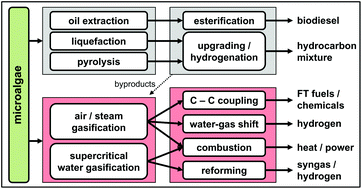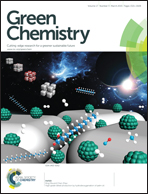Simulation and life cycle assessment of algae gasification process in dual fluidized bed gasifiers
Abstract
We present simulation results for the production of algae-derived syngas using dual fluidized bed (DFB) gasifiers. A global sensitivity analysis was performed to determine the impact of key input parameters (i.e. algae composition, gasification temperature, feed water content, steam-to-biomass ratio, and fuel-air equivalence ratio) on the product yields. The algae oil content was varied from 0 to 40 wt% to account for different algae strains and varying extents of oil extraction prior to the gasification process. It was found that the lower heating value (LHV) of syngas, typically ranging from 15 to 22 MJ kgalgae−1, is heavily dependent on the algae oil content. The cold gas efficiency (CGE) of the process varies over a range of 75 to 90%, depending primarily on the feedstock water content and steam-to-biomass ratio. A cradle-to-grave life cycle assessment indicated that the carbon footprint of syngas produced from algae feedstocks with 20 to 40 wt% oil fraction that is dried by a gas-fired dryer lies within a range of 70 to 195 g CO2 MJ−1. However, decarbonization of the drying stage via utilization of solar energy reduce the carbon footprint to values below 40 g CO2 MJ−1, which would compare favorably with the carbon footprint of syngas produced via steam reforming of natural gas (i.e. ∼100 g CO2 MJ−1).


 Please wait while we load your content...
Please wait while we load your content...